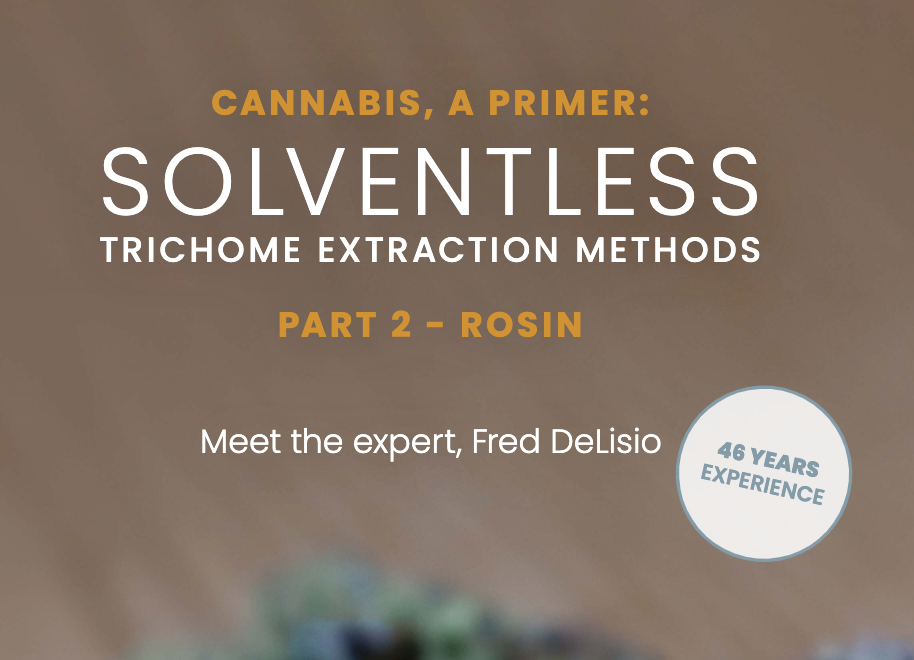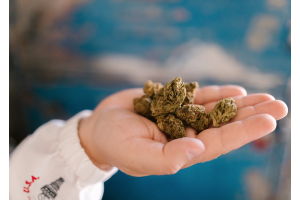Cannabis, A Primer: Solventaless Trichome Extraction Methods, Meet the expert, Fred Delisio - Part 2

Here in the US, the MORE act has passed the House of Representatives, and has been forwarded to the Senate.
This bill removes marijuana from the list of scheduled substances under the Controlled Substances Act and eliminates criminal penalties for an individual who manufactures, distributes, or possesses marijuana.
The bill also makes other changes, including the following:
- replaces statutory references to marijuana and marihuana with cannabis,
- requires the Bureau of Labor Statistics to regularly publish demographic data on cannabis business owners and employees,
- establishes a trust fund to support various programs and services for individuals and businesses in communities impacted by the war on drugs,
- imposes a 5% tax on cannabis products and requires revenues to be deposited into the trust fund,
- makes Small Business Administration loans and services available to entities that are cannabis-related legitimate businesses or service providers,
- prohibits the denial of federal public benefits to a person on the basis of certain cannabis-related conduct or convictions,
- prohibits the denial of benefits and protections under immigration laws on the basis of a cannabis-related event (e.g., conduct or a conviction),
- establishes a process to expunge convictions and conduct sentencing review hearings related to federal cannabis offenses, and
- directs the Government Accountability Office to study the societal impact of cannabis legalization.
- I had to give this update, as, removing Cannabis (and renaming it, from “Marijuana” to cannabis) from the list of scheduled substances is a MONUMENTAL act, so much better than “legalization”, which basically gave birth to “Corporate Cannabis”, and all that implies, while doing very little for the individual, who needs it for medicine, and wants to grow their own.
Alright, onward to the subject at hand...ROSIN.
In part 1, we reviewed the various methods of solventless extraction of “the good stuff” (esters, flavonoids, terpenoids and cannabinoids) from cannabis flower and trim, in the form of resin heads and capitate stalks, and I left you with:
“Here is where my story ends, as now you are free to vaporize your hash product, dab it, or press it into rosin.”


Rosin: the pure extract of hashish, leaving all of the capitate stalks and waxy resin heads behind, presenting only the terpenes, esters, flavonoids and cannabinoids intact.
Back in 2013, there was a person that picked-up cannabis, and cannabis extract samples to be tested by a fairly large testing laboratory, here in Southern California, as we have been making dosed-cannabis medications for doctors for many years, and he was telling me about something they were playing around with in the lab, a press, that could literally squeeze the pure essence out of cannabis, and trichomes, and they were calling it “ROSIN”.
That person went on to start one of the largest rosin press companies in the cannabis market today (I won’t name names), but suffice it to say, hindsight is always 20/20.
This is where we will explore rosin, and the making of rosin, from hash or pressed flower.
We’ll start with pressing cannabis flower, as that is the starting point with all of this, and it's very easy to do.
Let me begin by saying, the actual art of pressing rosin from cannabis flower must be learned by trial and error, and what I’m going to go through is an overview of how that is accomplished.
With regard to actually pressing your material, this will give you a head-start, so that if you are considering entering into the world of rosin, when you purchase your press, to begin this journey, you will be prepared.
All you need is a hair straightener, a “C- clamp”, and some parchment paper to start, although, within a few hours, days, or weeks at the most, you’ll be ready to purchase a rosin “press”, as you’ll be amazed at the differences between rosin and all other forms of concentrates.
The fact is, you don’t need a 10-ton press to create quality rosin -- pressing cannabis flower takes between 600 and 1000 pounds of pressure to yield beautiful rosin.
Pressing hash requires less pressure, as you have isolated the trichomes only, and it requires only 300 to 800 PSI to press out the contents of your trichomes.
Cannabis flowers are covered in trichomes, which we learned to wash off in the last part of this series, but the flowers can also be pressed without washing to reclaim the “goodness”.
The next thing you’ll need is what is referred to as a “pollen press”, traditionally used to press hash into “pucks”, but very useful to press flower into pucks for pressing for rosin.
What this does is compact the flower into a very small, round “puck” (named after a hockey puck, which it resembles, just much smaller).
You can press 3.5 - 7 grams of buds/flower into pucks very easily with this tool, and they are available for purchase online very inexpensively. This is an indispensable tool for producing high-quality rosin from cannabis flower.
Of course, the old computer acronym of “GIGO”, or “Garbage In, Garbage Out” applies very well to this. The more trichome-laden the flowers, the better quality, and quantity of rosin you will yield, as always, quality is key. However, when pressing cannabis flower, there are aspects beyond quality that need some consideration. Primarily, freshness and moisture content of your bud will affect your rosin the most.
Fully dried bud isn’t the best starting material for making flower rosin. Fresh uncured cannabis that has been frozen almost immediately after harvesting is the most desirable candidate, thanks to its higher cannabinoid and terpene content. The moisture in fresh buds also acts as a buffer to help release more oils, instead of them being sucked up like a sponge by the dry plant material of cured bud.
The key here is monitoring and knowing the relative humidity of the flower intended for use.This is very important, because if your buds are too dry, the oil that is being pressed out, will be absorbed by the dry plant material.We need the flower to be high in moisture content (with a relative humidity of at least 55%, and even more optimally, around 65%.This keeps the flower moist and helps expel the oil to the outer edges when pressed, separating it from the plant material.
Of all the different variables of rosin making, correct pressing times and temperatures are the most important for the best results.
It’s also the area that is open to experimentation and debate. Reaching the perfect settings can be challenging, and is an art to perfect, so whether you go low and slow or high and fast a good understanding of how these two parameters affect quality and yield is important to produce the best rosin you can.
Temperatures can range from as low as 135-165 degrees Fahrenheit/57 to 74 degrees Celsius, to 220 degrees Fahrenheit/105 degrees Celsius, but I wouldn’t recommend much higher, as you will be destroying terpenes and other volatile compounds at higher temperatures
Generally, lower temperatures are better, as they don’t decarboxylate the end product, and retain a far wider range of terpenes, which begin to evaporate immediately upon pressing (making the lab/workshop/house smell delicious!).
The pressure spectrum for rosin sits roughly between 300 and 1000psi. Flower requires more pressure, closer to the upper range of 600 to 1000psi, whereas dry-sift or bubble hash only requires lower pressure, at 300 to 800psi.
Ultimately what pressure to use will vary from press to press. Differing pressures will also be determining factors for time and temperature settings, so it’s important to experiment with the three variables if you want to keep improving the quality of your rosin.
The cannabis flower puck is placed into a mesh bag before pressing, to contain the plant material as it is being pressed.
Generally, for flower, I use 90-micron mesh bags; for hash, I use 25-micron mesh.
Filtering also has a big impact on rosin quality and yields.
Generally, the smaller the micron rating of your bag, the higher the quality of rosin produced, but at the expense of yield. This is because finer micron values only allow resin packed trichome heads to pass through them, leaving behind larger, lower grade particles.You can either try to strike a balance between potency and yield with a larger micron rating, or you can specifically target the premium trichomes with a super fine mesh. However, there’s always going to be a trade-off between the two.
Stabilizing Rosin - Freezer, here we come.
Once you’ve improved your rosin making process, there’s one final step to maximize the quality and shelf-life of your concentrate, which is to stabilize and cure your rosin.Rosin is a collection of volatile essences and oils which degrade very quickly, so it’s important to preserve it as best we can. Just place it in the freezer. In as little as 15 to 20 seconds, it will turn precious terpene vapor into oils again, especially if it has a more liquid consistency.
I leave it in the freezer overnight.
This will increase the lifespan of your rosin by reducing its volatility, especially when it comes into contact with the air.
To cure it, simply store it in a dark place, in an airtight, glass container (no silicone, terpenes are solvents), after the initial visit to the freezer.
Parchment paper is used between the heated plates when pressing cannabis flower or hash, because cannabis rosin can be collected fairly easily from it once the pressing is done, with a small knife, or metal sculpting that can also be purchased online. When pressing cannabis flower, a 30-60 second “warm-up” between the plates yields best results. With the puck firmly seated between the plates, give it one or two pumps, until the puck is compressed a bit. Allow it to warm between the plates for a bit, before pressing further. This will allow the plant material and oils to warm and soften, and will assist in the final extraction.
I always try and press at the lower end of the temperature range, to preserve terpenes and more volatile compounds.
There are many affordable presses out there, and a 4-6 ton press is capable of more than enough pressure to produce top-grade rosin.
Have fun with it, experiment with various pressures and temperatures, as each press is slightly different, as well as each cultivar having unique characteristics, depending on environment, curing and relative humidity, as discussed above.
To assess the relative humidity of your flower, you can buy a small hygrometer very cheaply online, that is Bluetooth, syncs with your phone, and allows you to view a graph of the humidity, and you can rehydrate flower easily with a piece of fresh stem or leaf, or a damp paper towel placed on top of the container and screwing the lid on.
I don’t ever use the various humidity packs on the market, as they tend to pull terpenes and are not a natural way of rehydrating cannabis.
Hash is pressed at a slightly lower pressure, but otherwise, the methodology is the same, other than the fact that hash needs much less pressure to press the rosin out, and the yields are much better, and purer.
For hash, I always use a 25-micron bag, since I am only pressing trichomes, and the smaller mesh holds in the tiny trichomes better than a larger mesh size.
I HAVE to add, I'm partial to pressing flower, over hash, unless a large amount is needed.
I LOVE the variety of Cannabis, and I press only what I can consume in a week or two, of each cultivar, so it's fresh.
With regards to mesh bags, you can buy rolls of mesh tubing in different micron sizes, cut it to size, and just fold the ends over the puck like you're wrapping a gift, and slip it in between the parchment/plates.
That’s about it for producing rosin - now go, and have fun with it!
That’s it for pressing rosin - everyone stay safe, and be well.
Written and Published By Fred Delisio in Weed World Magazine issue 150












Validate your login